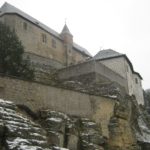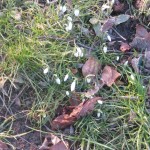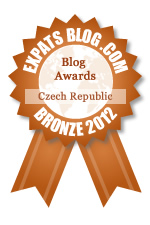
Towers at the eastern end of the Prague Castle complex © Ricky Yates
Many of us here in Prague, are beginning to think that someone has kidnapped Spring and early Summer, the weather having been cold and wet for most of May. So Sybille and I decided to take full advantage of a rare, fine, dry and partly sunny evening earlier this week, and take a walk through some of Prague’s wonderful green spaces.
We took the tram to Pražský hrad / Prague Castle. But instead of crossing Prašný most, the bridge over Jelení príkop, and entering the Castle complex, we turned left into Královská zahrada, the Royal Gardens. As well as a wonderful collection of mature trees, there were several rhododendron bushes still in flower – shades of our visit to Pruhonice Park the previous week.
From the Royal Gardens, there are splendid views of Prague Castle. This photo shows the towers at the eastern end of the Castle complex. However, surrounded by trees and other greenery, you could be forgiven for thinking it to be scene from a small historic village in the Bohemian countryside, rather than a location in the centre of the Czech capital.

The view from Chotkovy sady © Ricky Yates
At the eastern end of the Royal Gardens is Chotkovy sady, from where this view down to the Malostranská tram stop with Charles Bridge beyond, was taken. From this point, a pedestrian bridge allowed us to cross the road and tram tracks below, and enter a far bigger green space, Letenské sady or Letná Park, as it is commonly called in English.

The Metronome in Letná Park © Ricky Yates
Letná Park occupies a plateau from which a steep slope goes down to the Vltava river. Walking along the path at the top of the slope, there are extensive views across the whole of that part of Prague that lies on the eastern side of the river. But sitting on top of a massive plinth and occupying the best viewpoint of all, is this slightly incongruous metronome. At least when we saw the metronome on our walk earlier this week, it was actually working. More often than not, it is stationary!
The metronome was erected in 1991, but the massive plinth on which it sits, has a far longer history going back to late 1949, only eighteen months after the coup that brought the Communist Party to power in February 1948. For on it once stood the largest group statue in Europe, measuring 15.5 metres in height and 22 metres in length.
Seeking to kowtow to the Soviet Union, the Central Committee of the Communist Party in Czechoslovakia decided to build a massive statue of Joseph Stalin. It took them five and a half years to construct it and, by the time it was unveiled on 1st May 1955, Stalin had already been dead for over two years.

The Prague Stalin Statue – Image via Wikimedia & in the public domain
As you can see, the group statue was a classic example Communist era art on a gigantic scale. Stalin stands proudly overlooking the Vltava River, with archetypal workers and soldiers lining up behind him. The statue was informally known as ‘Fronta na maso‘, the ‘meat queue’, which was a daily part of life at that time. I am given to understand that there were also some far more descriptive titles – those that referred to what comrades standing behind Stalin, might be doing to his rear 🙂 As long as they are not too offensive, I’d love to know what these were, via comments on this post.
Less than a year after the statue was unveiled, Nikita Khrushchev denounced Stalin, both for his dictatorial rule and his cult of personality. Thus, this grand monument became an increasing embarrassment to the Czechoslovak Communist hierarchy. Therefore, in October 1962, the whole colossus was blown up with the help of 800 kg of explosives.
From the platform, immediately below the metronome, there is a view straight across Cechuv most, towards Staromestké námestí / Old Town Square. The street from the bridge to the square is called Parižská / Paris Street. Either side of Parižská, are some of the most exclusive and expensive shops in Prague. It is a view I suspect, that Stalin would not enjoy. So it is probably good that he no longer has to observe it 🙂

The view from Letná Park over Cechuv most © Ricky Yates






Ricky, congratulations on enjoying a good evening in Prague. I was at the Veletržní palác yesterday and saw the draft of the Stalin statue, there was also a student/academic on there. The permanent collection also contains Antonin Slavicek’s rather good “Letna”.
Letna’s got a lot more going on than just the plinth, though. There’s the Kramar Villa, which is the official residence of the Prime Minister, the lovely Hanavsky pavillion, which’s now a chi-chi cafe, where a friend and I once saw a sign for fresh strawberries and wiped cream.
On the history side, it was also the site of the greatest demonstrations of the Velvet Revoulution. Also, it’s a great place for a beer, for flying a kite, and for turning one’s back on Sparta stadium. Plus it’s got a super tunnel going underneath.
Thank you David. As always when you write about somewhere, there are inevitably other things you could include. I agree with you that the official residence of the Prime Minister and the Hanavský Pavilion, (Btw, only one ‘l’ in ‘pavilion’ 🙂 ), are both architecturally attractive buildings. And we did end our walk with a beer in the Letná Beer Garden!
I enjoyed you observation of ‘wiped cream’ – another excellent example of Czenglish. I’ve driven through the road tunnel numerous times because it’s on the direct route from home to Church on the occasions we drive there rather than using public transport. But as for ‘the Velvet Revoulution’, did you by any chance mean ‘the Velvet Revolution’??? 😉
Perhaps I should ask you to proofread my posts before I send them.
And after “I enjoyed you observation of ‘wiped cream’”, I can proofread yours.
David – as you have on several occasions, picked up errors in my spelling & punctuation, all of which I have confessed & acknowledged, I cannot resist pointing out the occasional one of yours. And then I go and miss out the ‘r’ on the end of ‘your’…… 🙁
How lovely to revisit one of my favourite parts of Prague. Super photos, but I can’t help wondering what the views look like now with the river so very high. I’m assiduously keeping up with the news from Central Europe and devoutly hoping that the floods aren’t as destructive as 2002, though I’ve just read that the Zoo is being badly affected. 🙁
Glad you enjoyed it Perpetua. My apologies for the time it’s taken me to approve your comment & reply. We suffered a side effect of the flooding when, at around 21.15 in the evening of Monday 3rd June, our landline went dead & with it, out internet connection. According to O2, our phone & internet provider, there is a ‘technical problem in our area’ which I presume means flood water has got into the system somewhere. We still have no internet so my laptop has come into its own as I can carry it to Bar-Restaurace U Topolu where they still have functioning wifi. I’m replying to your comment having just had lunch at U Topolu. Before coming here, I drafted a whole load of emails & then was able to send them. Good excuse to be in the pub 🙂
I have a two thirds written & illustrated post about the floods which I was going to post on Monday evening…….
I just love your photos of Prague Ricky, even during the flood. They bring back many fond memories. The painful part is the fact we are not there enjoying that wonderful city. We were in Prague for the 2002 flood, indeed Elaine was downtown on the East side of the river when the bridges were closed. She got the last subway train on the green line under the river. The train passed through the Starometska, and Malostranska (probably bad spelling) underground stations where people were standing on the platform waiting without stopping for them. It turned out that those stations had been closed at the entrances (Elaine had tried to enter them) and sandbagged, and people had entered anyway expecting to be picked up.Elaine was astonished when the train went right through station without stopping.She has a tee shirt that identifies her as a survivor of the 2002 floods.
In regard to the royal gardens, Elaine spent many hours there when we lived in Prague, because it was a good spot to read and meet me after I finished work, and before we went to dinner. She also used to sit in St. Vitus in the heat of August where the thick stone walls kept the building cool.
She had an encounter in the Royal Gardens that I must relate. One day while sitting and reading, on a bench and elderly woman sat down on the opposite end of the bench. Elaine struck up a conversation in her halting German. The woman explained that during her younger years when the Nazis and then the communists had closed the gardens to the public and reserved them for only the elite members of the parties, the gardens were forbidden to her. In her old age and freedom she now came there everyday because she could! It almost brought tears to Elaine’s eyes. Those gardens had been closed to the Czech citizens from about 1939 or 40 until 1989. Elaine and I spent many wonderful hours sitting and reading in those gardens.
I read recently that the International Baptist Seminary in Jeneralka is moving to Amsterdam. We stayed in the hotel at that facility many many months and met many wonderful Christians who we still keep in touch with.
Thank you Robert, for this long & detailed comment. So glad you enjoyed these photos. I particularly liked you story of Elaine’s conversation with the elderly lady in the Royal Gardens.
Yes – IBTS is moving to the Netherlands in a year’s time. The are already winding down & the longstanding principal Dr Keith Jones, is returning to the UK next month.